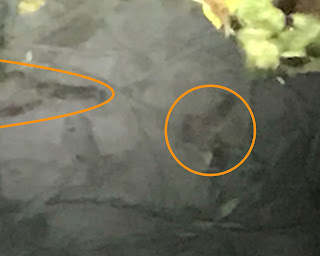Seeds have the power to preserve species,
to enhance cultural as well as
genetic diversity,
to counter economic monopoly
and to check the
advance of conformity on all its many fronts.
~ Michael Pollan
 |
| Cowpen Daisy hanging on to the last of the warm weather. |
People use this park.
 |
| I love this park. |
As I exited the car in the packed lot, a little girl greeted me from the next car over. I suspect her father reminded her of "stranger danger" rules as I found my binoculars and made sure I had all the pre-labeled plastic bags in my pockets. She did not speak or wave again.
I knew where the requested wildflower seeds SHOULD be and went right to them. Only one species was blooming (convenient for me - these darned sunflowers, asters, and daisy-like plants can all look alike - even when blooming). The tomatoes of the nightshade* were exactly where I expected them to be. The willow nuzzled up to the bank so that I could sit and remove a few - with rhizomes in decent order. And the vining plant was where I had expected it to be.
The vine was the only question mark among the requests. I've only seen it in this park. I wasn't really sure if this was it or not. There were a few tiny blooms, but I'll just have to let JA figure it out.
Pied-billed Grebes, common at this pond, paddled and tipped in, fishing for dinner. The Great Blue Heron began the evening near the footbridge and moved to another spot where we observed it fishing as well. I love these somewhat gangly birds. In the past few weeks I have watched a GBH stalk its meal at three different spots -- fascinating.
 |
| The Great Blue Heron |
 |
| It had spotted its prey. Right after this photo the bird disappeared into a splash of water and came up with a fish. |
A woman stopped to ask about the Water-willow. She has a small pond in her yard (a very small pond). I told her that it was a spreader and probably not appropriate for such a small pond - really a tub. But what do I know, really. [I see them proliferating in the shallows of the park pond and make an assumption.] I showed her the flower on my phone and suggested she keep watching in the spring and summer. The blooms are lovely - almost orchids (photos from earlier in the year).
 |
| These delicate blooms make me happy. |
 |
| This may have been the first time I remember seeing them. |
The rest of the watch group showed up within the hour. We were 20-strong, adults and children (one tiny young naturalist with his new headlamp). The frogs and toads were not interested in our numbers. They did not call. They did not write. Well, one cricket frog was observed, but not caught. [They don't count if you don't get a photo or recording.]
 |
| Lots of bobbing flashlights - hunting for frogs. |
A few of us gathered in the parking lot - we discussed what we had been doing and our plans for the remainder of the year.
Sunday update: The requester has been notified and the box addressed. The seeds are still in the car, waiting for me to wander out and re-label (with their Latin, scientific and more precise name**) and, perhaps, repackage. This was a fun exercise. I'm just glad the request wasn't for something observed in California ... or Ireland.
NOTES:
* A month ago I had warned the Cub Scouts about eating things they see in the wild - The Silver-leaf Nightshade had cooperated by appearing in a few spots - in all their brilliant yellow tomato glory! I had warned another group a few weeks before that as a woman picked a stalk-full. I KNOW they are toxic. It is some of the others that worry me more - the Queen Anne's Lace/wild carrot/Hedge parsley/Hemlock, for example. The are all so similar, but some will kill you. Don't get me started on mushrooms.
**I use the "common" names for my convenience, but there are often a number of plants with the same or similar "common" name.
FINAL NOTE:
We did see a surprising number of LARGE crayfish. They didn't like the light and hid pretty quickly. The photos are awful, but give a little feel for what we were seeing.



No comments:
Post a Comment
Thanks for coming along on the walk. Your comments are welcome.